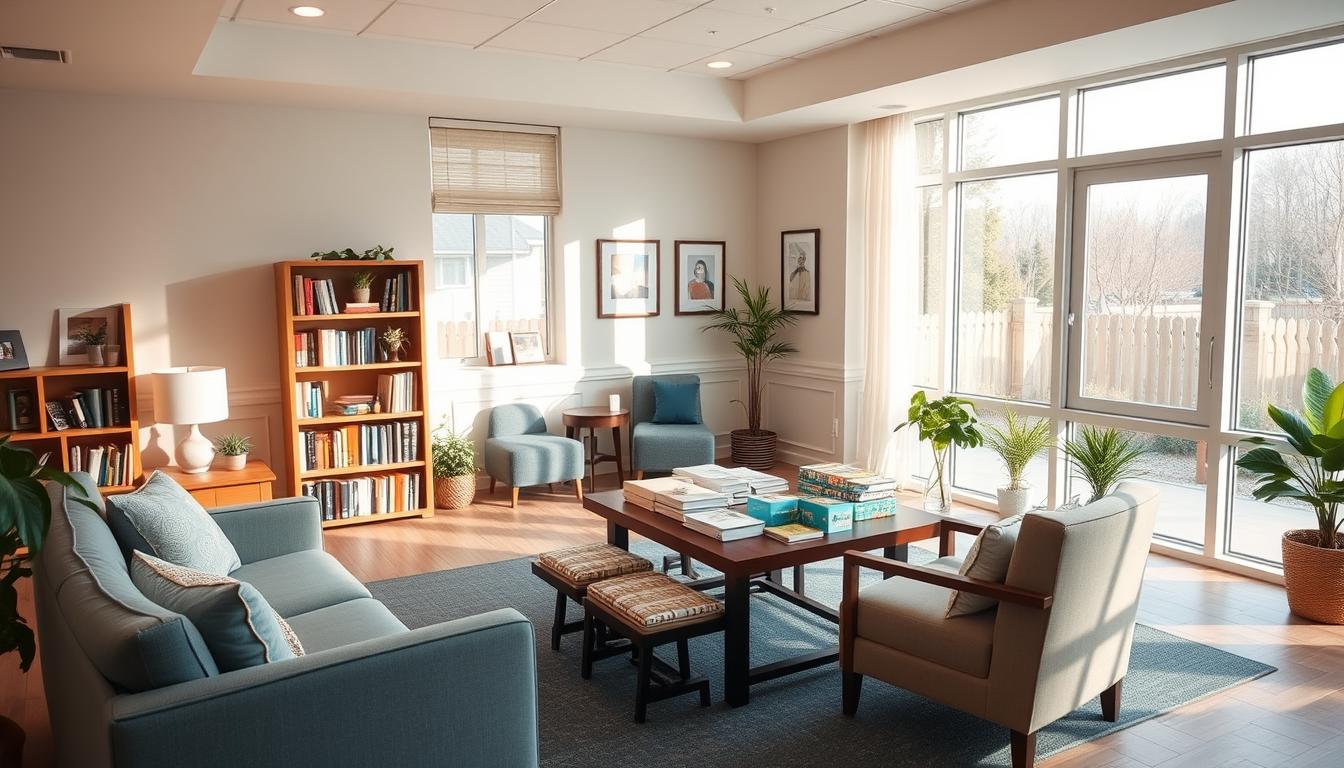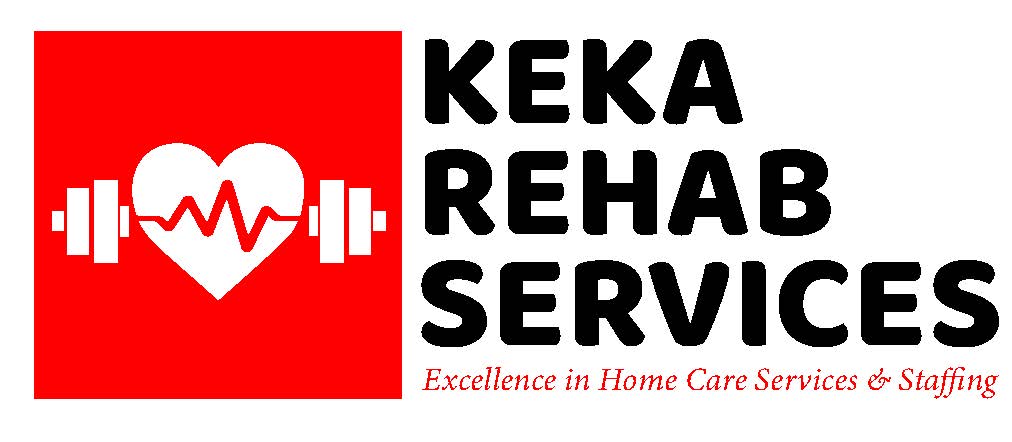Did you know senior rehab can cut hospital readmissions by up to 80%? This shows how vital expert care is for seniors. It helps them improve after surgery, manage health issues, or heal from injuries.
Places like Wilson Health Care Center in Gaithersburg, MD, offer many services. They have physical and respiratory therapy and programs for brain conditions. They also have experts for dementia and voice treatments.
Rehab isn’t just about getting better physically. It also helps with thinking, feeling, and returning to daily life. You can get inpatient care with nurses all day or outpatient therapy for ongoing help.
They offer treatments like LSVT BIG for Parkinson’s and special splints for arthritis. You’ll have a structured day with therapy and comfy private suites. Everyone’s recovery is different, but with the proper care, you can regain your independence.
Key Takeaways
- Senior rehabilitation services significantly reduce hospital readmissions
- Comprehensive programs include physical, occupational, and speech therapy
- Certified specialists provide expert care for various conditions
- Both inpatient and outpatient options are available
- A holistic approach addresses physical, cognitive, and emotional needs
- Structured programs and amenities support faster recovery
Understanding Senior Rehabilitation Services
Senior rehabilitation services help older adults recover from health issues and return to independent living. This is especially true after they leave the hospital or undergo medical procedures.
What Is Post-Hospital Care for Seniors
Post-hospital care is special treatment for seniors after they leave the hospital. It helps them recover and strengthen. Depending on the patient’s needs, this care can be provided in special facilities or at home.
Types of Rehabilitation Programs
Senior rehabilitation programs include physical, occupational, and speech therapy. Each therapy is tailored to the patient and helps them improve. Physical therapy makes patients more potent and more mobile. Occupational therapy helps with everyday tasks. Speech therapy fixes problems with talking and swallowing.
Benefits of Professional Rehabilitation Care
Professional care for seniors has many good points. It can lessen pain, boost physical skills, and help them be more independent. Medicare patients usually stay for 26.4 days, giving them enough time to heal. Even though costs can be high, with a month costing $8,000 to $9,000, there are ways to pay. Options include Medicare, Medicaid, and private insurance.
Comprehensive Rehabilitation Treatment Options
Top rehabilitation centres offer many treatment options for seniors. Physical therapy helps with movement, balance, and flexibility, and it can help seniors feel more independent and confident.
Occupational therapy is also key. It helps with daily tasks like dressing and cooking. It’s often paired with physical therapy for a complete recovery plan.
Speech therapy helps with talking, swallowing, and thinking problems. It’s excellent for those recovering from strokes or with brain issues. UCLA Health’s Speech Pathology Clinic offers both inpatient and outpatient services.
Many places offer care plans that mix these therapies. Seal Beach Health & Rehabilitation, for example, offers 24/7 care. They have physical, occupational, speech, and recreation therapy.
Places like UCLA Health have big teams of experts. They have over 300 team members and 25 locations. They make sure patients are pleased, with over 90% satisfaction.
Medical Conditions Requiring Senior Rehabilitation
Senior rehabilitation helps older adults with many health issues. It aims to strengthen them, improve their quality of life, and help them stay independent. This is especially true after they get sick, hurt or have surgery.
Post-Surgical Recovery
Many seniors need rehab after surgery. This could be after getting a new joint or heart surgery. They get help to get stronger and move better. Many places have physical therapists come to help them recover.
Chronic Disease Management
Managing long-term health issues is key for seniors. Over 350 million people worldwide have arthritis, which requires ongoing care to manage pain and stiffness in their joints.

Injury-Related Rehabilitation
Rehab is essential for seniors after falls or breaks. These can hurt their ability to move and be independent. Short-term rehab helps them get back to how they were before.
As people get older, they might need help with daily tasks. Places like Skilled Nursing Facilities offer therapy to help them. They provide physical, occupational, and speech therapy to help them do things independently.
Physical Therapy for Elderly Patients
Physical therapy helps older adults live better lives. It’s for people 65 and older. As we age, our bodies change, making it harder to move, be strong, and balance. Therapy helps with these issues.
Mobility Enhancement Techniques
Geriatric physical therapy uses unique methods to help older adults move better. It includes stretching, endurance training, and strengthening exercises. Therapists work on muscles like the legs and calves, assisting seniors to walk faster, stay steady, and avoid falls.
Balance and Fall Prevention
Fall prevention is a major goal of physical therapy for the elderly. Balance exercises improve coordination and quickness. Therapists also teach seniors how to use walkers or canes safely, lowering the chance of accidents.
Strength Training Programs
Strength training is key for keeping muscles and bones strong in older adults. Therapy programs include exercises for the lower body. These exercises boost strength and help with arthritis symptoms, and they might even delay the need for surgery.
Older adults should engage in at least 150 minutes of moderate activity weekly, including exercises for strength, balance, and flexibility. Working with a physical therapist can help seniors meet these goals safely, leading to a better quality of life and more independence.
Occupational Therapy Services
Occupational therapy is very beneficial for seniors. It helps them feel more independent and live better lives. Therapists teach them how to perform daily tasks and make their homes safe.
Seniors who had strokes find it hard to do simple things. This is because they lost strength and control. Occupational therapy helps them get back to doing things on their own.
Therapists work on tasks like getting dressed and eating. They help with problems like weakness, trouble seeing and thinking clearly.
These services include many areas, like:
- Return to independent living
- Mental health promotion
- Home Safety
- Vision rehabilitation
- Falls prevention
Therapy is available in clinics, homes, and online. This makes it easy for seniors to get help where they feel safest.
Therapists look at how seniors do things physically and mentally. They might suggest tools or changes to make life easier.
Occupational therapy significantly improves life for seniors, especially those who had strokes. It helps with eating, feeling good emotionally, and staying healthy.
Speech and Cognitive Rehabilitation
Speech and cognitive rehabilitation are key in senior care. They help with communication, swallowing, and thinking skills. Programs include speech, mental, and swallowing therapy for seniors’ needs.

Communication Skills Development
Speech therapy is vital for stroke patients. It helps with speaking, understanding, and talking. Therapists help seniors with speaking, saying words right, and getting messages.
Swallowing Therapy
Swallowing therapy is key for eating and drinking problems. It strengthens the mouth and throat muscles, helping seniors eat properly and avoid choking.
Cognitive Function Enhancement
Cognitive rehab improves memory, focus, problem-solving, and choices in seniors. It treats ADHD, schizophrenia, and depression. A 2019 review found it works well after brain injuries or strokes.
Recent studies show cognitive rehab works well. A 2022 review found it helps with daily tasks for those with mild brain issues. It helps many seniors, like those with dementia and Alzheimer’s.
Inpatient vs Outpatient Rehabilitation Options
Rehabilitation services are tailored to your needs. Based on your health and support, you can choose inpatient or outpatient care.
24-Hour Skilled Nursing Care
Inpatient rehab gives you care all day, every day. It’s for serious injuries or surgeries. You’ll see therapists for at least three hours a day.
Outpatient Treatment Plans
Outpatient rehab involves visiting a centre a few times a week. Sessions last 30 minutes to an hour and can be done up to five days a week. It’s good if you can live at home and still get better.
Home-Based Rehabilitation Services
Home-based rehab lets therapists come to you. It’s flexible and comfortable, especially for those who can’t travel. Your progress depends on your effort between sessions.
Each option, inpatient, outpatient, or home-based rehab, aims to improve your life. The right choice helps you reach your recovery goals.
Specialized Equipment and Technology in Senior Care
Senior rehab centres now use the latest tech to help people get better. They have cool physical therapy tools and unique gear for seniors. Many places have unique rooms with high-tech stuff for seniors to use often.
Wearable tech is changing senior care. It tracks health in real-time and helps seniors live independently. Smartwatches and patches monitor heart rates, blood pressure, and sugar levels. They also detect falls and send alerts. These gadgets can lower hospital visits by 40%.
Smart homes make life safer for seniors. Voice helpers and lights that turn on automatically improve their quality of life. Nest thermostats and sensors also keep homes safe.
Telehealth is big in senior care. It lets doctors visit virtually and check patients’ health from home, which means fewer trips to the doctor. Telehealth can save seniors up to 30% on healthcare costs, cutting down on doctor visits, travel, and home care costs.
In senior care facilities, devices like pendants track where people are and alert staff if they wander off or need help. Wireless carts perform medical tasks immediately, saving time and reducing mistakes. Automatic IV drips ensure that medications are given correctly.
These techs build trust by making places safer and improving talks between seniors, families, and caregivers. They keep an eye on health in real-time. This makes a safer and more comfy place for seniors in rehab.
Medicare Coverage and Insurance Options
Understanding Medicare for senior rehab can be challenging. We’ll make it simpler for you.
Understanding Coverage Benefits
Medicare helps a lot with senior rehab. Part A covers rehab in skilled nursing facilities and hospitals, and it also covers up to 100 days in a skilled nursing facility after a hospital stay.
2024 you’ll pay $1,632 for the first 60 days of inpatient care under Part A.
Additional Financial Resources
There are more ways to handle costs. Medicare Part B covers outpatient therapy and visits up to $2,330. You’ll pay 20% of these costs.
Look into Medicare Advantage or Medicare supplement plans. They might offer better deals for rehab services.
Insurance Requirements
To get Medicare, you must meet specific rules. For skilled nursing care, you need a 3-day hospital stay. If you go straight from the hospital to rehab, you might not pay a deductible.
Always talk to your provider and Medicare. They can tell you about your coverage and any costs you might have.
